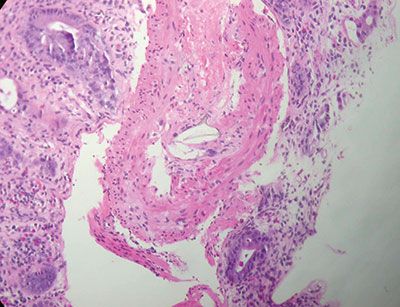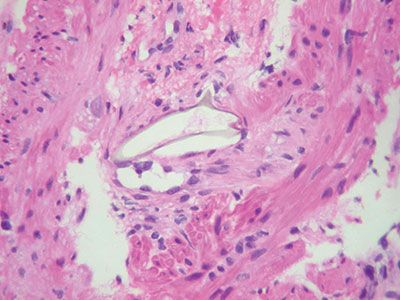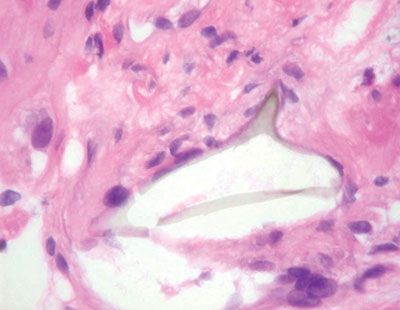- Clinical Technology
- Adult Immunization
- Hepatology
- Pediatric Immunization
- Screening
- Psychiatry
- Allergy
- Women's Health
- Cardiology
- Pediatrics
- Dermatology
- Endocrinology
- Pain Management
- Gastroenterology
- Infectious Disease
- Obesity Medicine
- Rheumatology
- Nephrology
- Neurology
- Pulmonology
Schistosoma mansoni Colitis in an AIDS Patient
A 33-year-old man from the Ivory Coast (who had been living in the United States for the past 8 years) received a diagnosis of AIDS when he presented with Pneumocystis jiroveci pneumonia. His CD4+ cell count was 6/µL, and his HIV RNA level was 575,000 copies/mL. He also presented with altered sensorium and seizure activity and was found to have obstructive hydrocephalus and ring-enhancing lesions in both cerebellar hemispheres and basal ganglia. Results of polymerase chain reaction testing of cerebrospinal fluid for Toxoplasma gondii were positive, and treatment for toxoplasmosis was started. A ventricular-peritoneal shunt was placed.
A 33-year-old man from the Ivory Coast (who had been living in the United States for the past 8 years) received a diagnosis of AIDS when he presented with Pneumocystis jiroveci pneumonia. His CD4+ cell count was 6/uL, and his HIV RNA level was 575,000 copies/mL. He also presented with altered sensorium and seizure activity and was found to have obstructive hydrocephalus and ring-enhancing lesions in both cerebellar hemispheres and basal ganglia. Results of polymerase chain reaction testing of cerebrospinal fluid for Toxoplasma gondii were positive, and treatment for toxoplasmosis was started. A ventricular-peritoneal shunt was placed.
The patient was discharged to a nursing home, where treatment for toxoplasmosis was continued and antiretroviral therapy with lopinavir/ritonavir and lamivudine/zidovudine was initiated.
After 4 weeks of antiretroviral therapy, the patient presented with a 3-day history of febrile illness (temperature of 40.5oC [105oF]) and diarrhea. Diarrhea was described as frequent (more than 10 episodes per day), small volume with urgency, nonbloody, greenish, bowel movements. His CD4+ cell count had increased to 36/uL. Empiric metronidazole therapy was started. His white blood cell count was 9500/uL, with 13% eosinophils. Multiple stool studies were negative for Clostridium difficile toxin, ova and parasites, and bacterial organisms.

Figure 1. A biopsy specimen from the colon reveals colitis with Schistosoma mansoni egg surrounded by granulomatous reaction (hematoxylin-eosin stain, original magnification ×40).
CT scans of the abdomen showed a “fluid-filled colon.” The patient underwent colonoscopy, which revealed a diffuse hyperemic colonic mucosa and prominent vasculitic changes consistent with colitis. A random biopsy specimen from the distal colon revealed severe active colitis with eggs consistent with Schistosoma mansoni infection. Some of the eggs were surrounded by granulomatous reaction (Figures 1, 2, and 3).

Figure 2. A biopsy specimen from the colon showing a Schistosoma mansoni egg (hematoxylin-eosin stain, oil immersion, original magnification ×50).
The patient was treated with praziquantel (1200 mg q8h) for 4 days, after which the diarrhea resolved. Eventually, the patient returned to the nursing home, where he continued his antiretroviral therapy.

Figure 3. A Schistosoma mansoni egg is seen in this biopsy specimen (hematoxylin-eosin stain, oil immersion, original magnification ×100).
Schistosomiasis
The World Health Organization (WHO) estimates that 600 million people are at risk for schistosomiasis. This infection is endemic in 74 countries; more than 80% of those infected live in sub-Saharan Africa.1 More than 200 million people are infected; 120 million of them have symptoms and 20 million have severe illness. Deaths are estimated at 4000 annually.1 S mansoni infection is endemic in the Ivory Coast.
HIV infection is also prevalent in the Ivory Coast. The WHO estimated that in 2005, 750,000 adults and children were living with HIV infection in the Ivory Coast and that 65,000 deaths had occurred that year in persons with AIDS.2
Common symptoms of acute schistosomiasis include fever, headache, generalized myalgias, abdominal pain, and bloody diarrhea.3 Chronic schistosomiasis secondary to S mansoni and Schistosoma japonicum infection leads to hepatomegaly caused by granulomas around embolized eggs. After years of infection, periportal fibrosis and portal hypertension develop in 10% of patients.3
Dual HIV infection and schistosomiasis is common in regions where the latter is endemic. In a prospective study of antiretroviral-naive HIV-infected patients in Zimbabwe who had bloody diarrhea, S mansoni infection was the culprit in 20% of patients (versus 45% with Shigella).4 A 10-year postmortem evaluation of patients with AIDS in Puerto Rico showed that 10% had histological evidence of infection with S mansoni.5 A Kenyan study found that HIV-positive men with low CD4+ cell counts are at higher risk for reinfection with S mansoni than are immunocompetent adults.6
The intestinal disease results from the host’s immune response to schistostome eggs and the granulomatous reaction evoked by the antigens they secrete.3 Poor granulomatous responses to mycobacterial and fungal organisms have been noted in AIDS patients. Studies have demonstrated that T-cell–deficient mice and patients with advanced AIDS have significantly reduced egg output.7 This fact could explain why multiple stool samples were negative in our patient.
de Silva and colleagues8 described a case of symptomatic S mansoni infection as an immune restoration phenomenon in a patient receiving antiretroviral therapy. A patient from South Africa presented with fever and diarrhea and also had normal results on several stool examinations. Colonoscopy revealed patchy sigmoid colitis. Mucosal biopsy specimens showed S mansoni ova with surrounding granulomatous inflammation. The authors suggested that this probable association between egg excretion and immune status could support the concept that immune reconstitution restored anti-schistosomal granulomatous responses in the gut mucosa that led to symptomatic enteritis, as seen in both cases.
Praziquantel is the treatment of choice for schistosomiasis and it can be used to effectively treat patients coinfected with HIV.9
Summary
Dual infection with HIV and S mansoni is common in sub-Saharan Africa. Physicians who treat patients with HIV/AIDS who have migrated from this region should be aware of this possible coinfection leading to symptomatic illness-especially as an immune reconstitution syndrome after initiation of antiretroviral treatment.
Acknowledgements: The author would like to thank Dr Caryn Sands for the histology pictures.
References:
References
1.
World Health Organization. Schistosomiasis.
http://www.who.int/tdr/diseases/schisto/diseaseinfo.htm.
Accessed November 9, 2009.
2.
Joint United Nations Programme on HIV/AIDS (UNAIDS). Epidemiological Fact Sheets on HIV/AIDS and Sexually Transmitted Diseases, Côte d'Ivoire 2006 Update. Geneva: UNAIDS; 2006.
3.
Ross AG, Bartley PB, Sleigh AC, et al. Schistosomiasis.
N Engl J Med
. 2002;346:1212-1220.
4.
Gwavava C, Chihota VN, Gangaidzo IT, Gumbo T. Dysentery in patients infected with human immunodeficiency virus in Zimbabwe: an emerging role for Schistosoma mansoni and Escherichia coli O157?
Ann Trop Med Parasitol.
2001;95:509-513.
5.
Climent C, DeVinatea ML, Lasala G, et al. Geographical pathology profile of AIDS in Puerto Rico: the first decade.
Mod Pathol
. 1994;7:647-651.
6.
Karanja DM, Hightower AW, Colley DG et al. Resistance to reinfection with Schistosoma mansoni in occupationally exposed adults and effect of HIV-1 co-infection on susceptibility to schistosomiasis: a longitudinal study.
Lancet
. 2002;360:592-596.
7.
Karanja DM, Coley DG, Nahlen BL, et al. Studies on schistosomiasis in western Kenya: I. Evidence for immune-facilitated excretion of schistosome eggs from patients with Schistosoma mansoni and human immunodeficiency virus coinfections.
Am J Trop Med Hyg
. 1997;56:515-521.
8.
de Silva S, Walsh J, Brown M. Symptomatic Schistosoma mansoni infection as an immune restoration phenomenon in a patient receiving antiretroviral therapy.
Clin Infect Dis
. 2006;42:303-304.
9.
Karanja DM, Boyer AE, Strand M, et al. Studies on schistosomiasis in western Kenya: II. Efficacy of praziquantel for treatment of schistosomiasis in persons coinfected with human immunodeficiency virus-1.
Am J Trop Med Hyg
. 1998;59:307-311.
